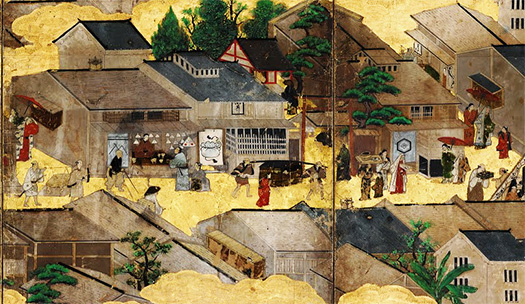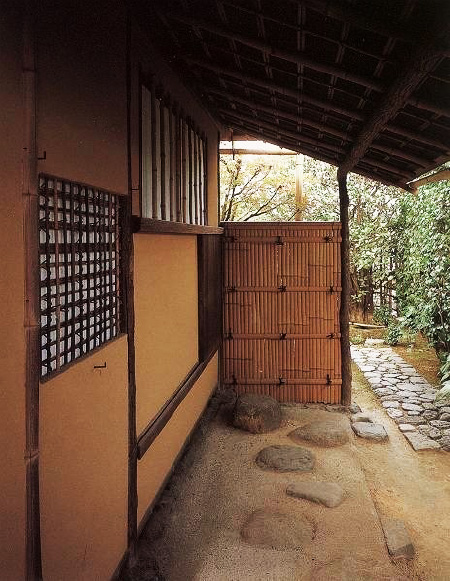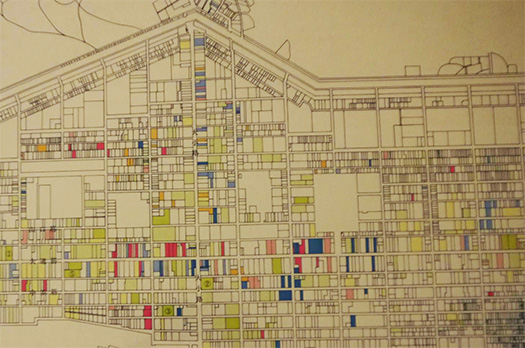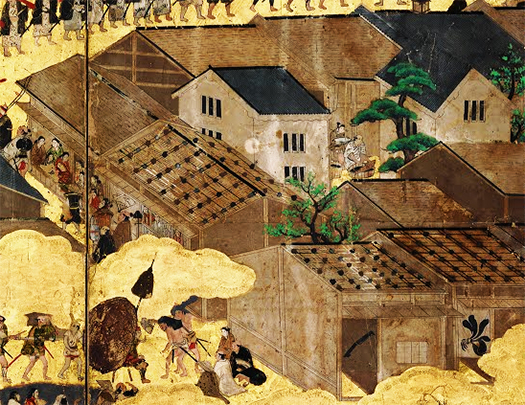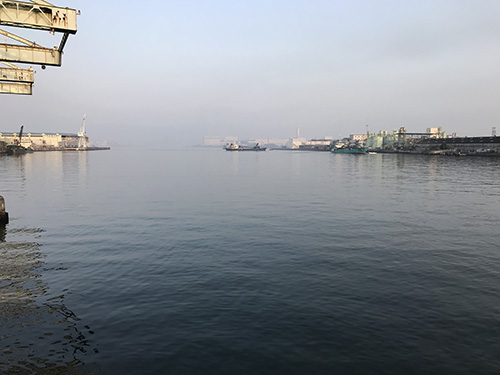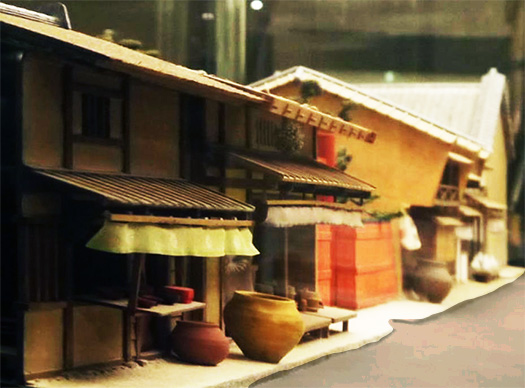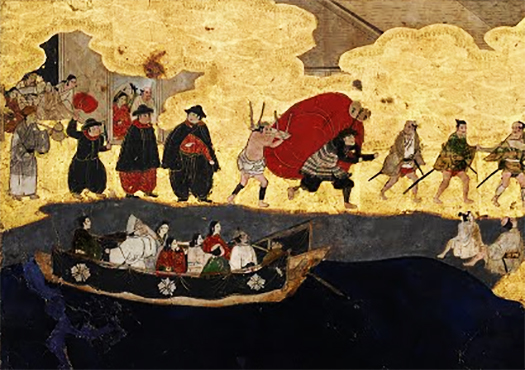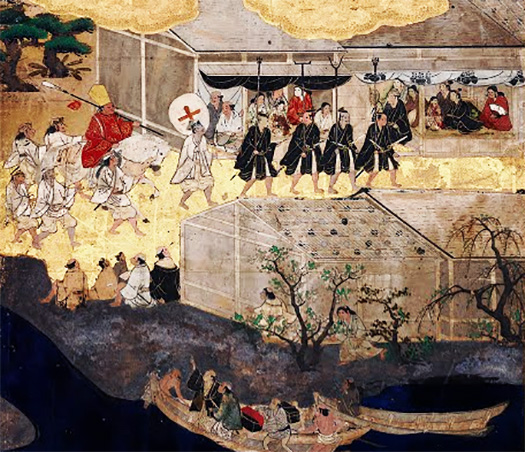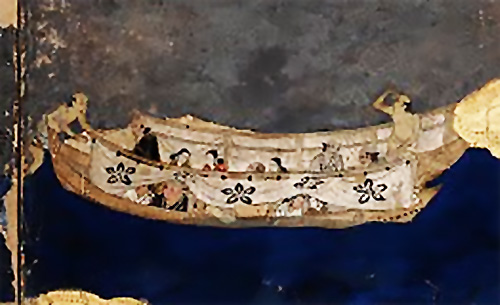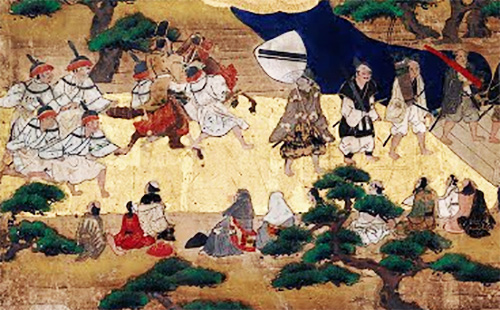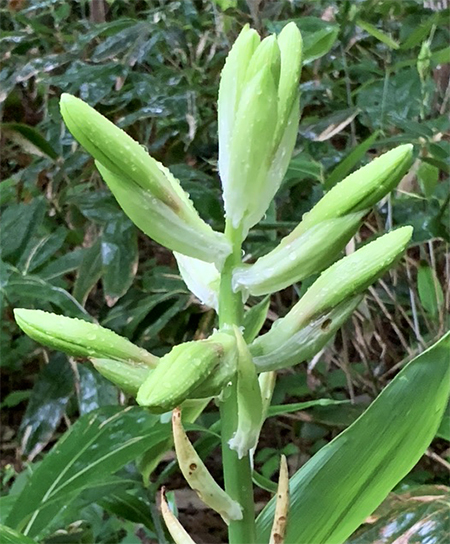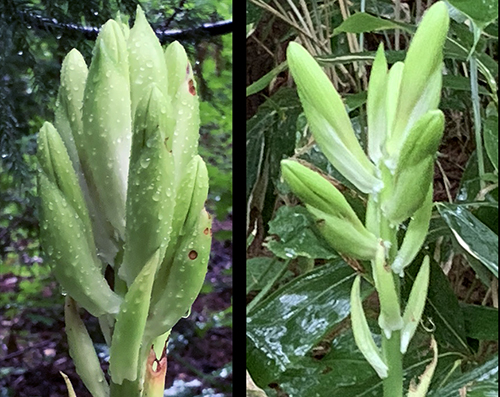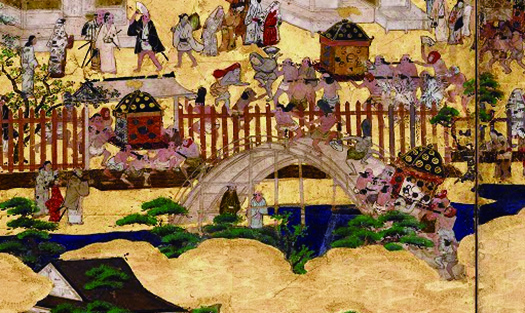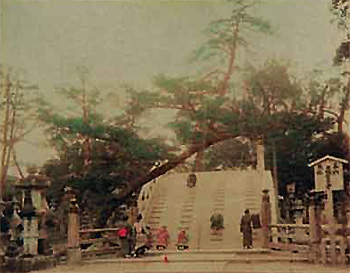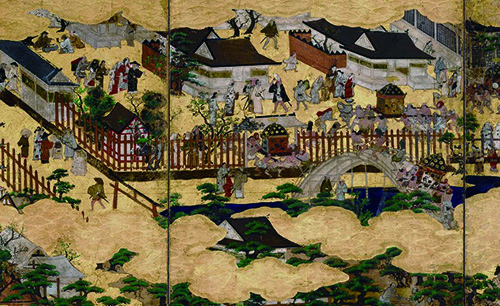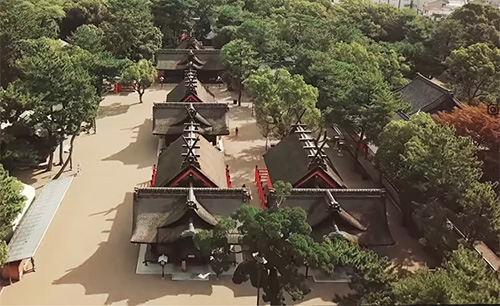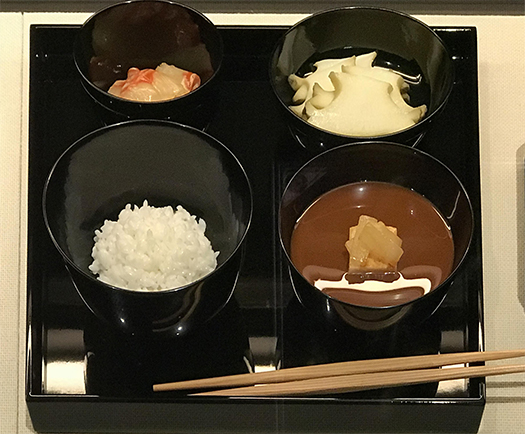
昔の人がどんな食事をしていたかを知ると、
突然、その人のことが具体的な体感で伝わってくる部分がある。
以前も安土城での家康を饗応接待した信長の膳部、
差配したのが明智光秀で、芝居的には信長が光秀を責めたシーンの会食膳。
信長の本能寺での頓死直前の歴史的会食機会。
「こんな料理を大切な家康の饗応に出すとはなにごとだ〜」みたいな。
「これは粗相をいたしました、すぐに換えさせます・・・」
「ええい、こんなものが食えるか(怒)」
信長・蹴飛ばす(光秀、深く「いつか殺してやる・・・」と恨む)。
となりで無表情を装う家康一行・・・。
その饗応膳が安土城記念館で展示されていて実に興味深かった。
「お、いい料理じゃん、信長さんそんなに怒らなくても・・・」(笑)
って言う印象を持ったりしておりましたが、
具体的な料理を見させていただくと、そのときの各人の心理まで
いわば身体の感覚で推し量れてくるように思われる。
たしかに信長という個性には癇癪持ちを感じるし、家康には分厚い無表情を思う。
信長公記という織田家の記録文ですら「お狂いあり」という記述があるといわれ、
そういう人物が軍事政治的天才の判断力でもって成功を収めていた様子が知れる。
天才はそばにいる人間にとっては災難でもあったのは間違いがないでしょう。
家康のような「同盟者」ポジションであれば冷静さで対処の仕様もあるだろうけれど
・・・事実、かれは信長の命令で最愛の息子と夫人の命を差し出さされている。
こういう信長に直接仕えるには白刃の上を歩くような気分があったと思う。
秀吉のように総身を投げ出すような自己演出まではできない
豊かな常識人である光秀には、ストレス満充電だったでしょう。
軍団長クラスは知られているけれどむしろ秘書的な人々のことを知りたい。
家康はこの会食後、堺見物に向かうけれど信長は自身の趣味生活の代表的管理人
長谷川という人物を案内役に付けている。興味深い。・・・

おっと、今回は堺市博物館で拝見した利休69歳のときの茶会での膳部であります。
利休はこの年齢で賜死したので数えか満年齢か不明ですが、最晩年の会食膳。
記録では死は1591年2月で、この会食膳は1590年という記録。
一汁二菜です。
利休の茶会で出された食事は、ほとんどが1つの膳で一汁三菜(飯、汁物、惣菜3品)に
近い仕立てで出されたという。禅に発祥する精進料理の影響から
余分を省いた簡素な品数だったとされる。
この料理は荒木道薫という人が招かれた際の記録から再構成とのこと。
メインは写真の通りで、串アワビ、フナのなます、味噌焼き汁、飯。
この膳部のほかに「麩の焼き」「シイタケ」が菓子として出された。
ほかの料理には詳細な記述がありませんでしたが、
「味噌焼き汁」とは、豆腐と細かく切った大根が入っている汁の料理。
また、麩の焼きとは小麦のふすまで作った一種の餅、という解説。
わたし的にはもうちょっと食いしん坊なので、少なめか(笑)
でも、アワビはこの時代、どの程度「高級食材」であったかを考えると
興味深いし、個人的には味噌焼き汁の具材2種というのが
ちょっとそそられるところであります。
細かく切った、というのがどの程度細かいのか、
また、豆腐の切り方はどのようであったか、
さらには味噌を一度焼いて保存性を高めていたのでしょうが、
どういった風合いであったか、また出汁はどう取っていたのか、
料理好きの部分を刺激される逸品だなぁと、妄想しております。
English version⬇
[Rikyu 69-year-old tea ceremony dinner / Japanese good house special edition ㊱-10]
When I learned what kind of meal people used to eat,
Suddenly, there is a part where the person is conveyed with a concrete experience.
Nobunaga’s Zenbe, who had been entertaining Ieyasu at Azuchi Castle before
It was Akechi Mitsuhide who delivered it, and in the play, Nobunaga blamed Mitsuhide for a dinner dinner.
A historic dinner opportunity just before Nobunaga’s sudden death at Honnoji Temple.
It’s like, “What’s the point of serving this kind of food to the important Ieyasu?”
“This was a rough phase, I’ll change it soon …”
“Yes, can you eat something like this (angry)”
Nobunaga kicks off (Mitsuhide, deeply resents “I’ll kill you someday …”).
Ieyasu and his group pretending to be expressionless next to them.
It was really interesting to see the dinner set on display at the Azuchi Castle Memorial Hall.
“Oh, good food, Nobunaga-san, you don’t have to get so angry …” (laughs)
I had the impression that
If you look at specific dishes, even the psychology of each person at that time
So to speak, it seems to be guessed by the sense of the body.
Certainly, I feel that Nobunaga has a tantrum, and Ieyasu has a thick expressionless expression.
It is said that even the Oda clan’s record, Nobunaga Koki, has a description that “there is a madness.”
It can be seen that such a person was successful with the judgment of a military and political genius.
There is no doubt that the genius was also a disaster for the people around him.
If you are in an “allied” position like Ieyasu, you may have a calm and coping specification.
… In fact, he has been given the lives of his beloved son and wife at Nobunaga’s command.
I think I felt like walking on a white blade to serve Nobunaga directly.
You can’t do self-directing like Hideyoshi throws out the whole body
Mitsuhide, who is a rich common sense person, would have been fully charged with stress.
The corps commander class is known but rather wants to know about secretarial people.
Ieyasu heads to Sakai after this dinner, but Nobunaga is a representative manager of his hobby life.
He has a person named Mr. Hasegawa as a guide. Interesting.・ ・ ・
Oops, this time it’s the table at the tea party when Rikyu was 69 years old, which I saw at the Sakai City Museum.
Rikyu died at this age, so it’s unclear if he’s counting or full age, but his last-year dinner.
Records show that he died in February 1591 and this dinner was in 1590.
It is one soup and two vegetables.
Most of the meals served at Rikyu’s tea party are one set and one soup and three vegetables (rice, soup, and three side dishes).
It is said that it was issued in a close tailoring. From the influence of the devoted cuisine that originated in Zen
It is said that it was a simple number of items without extras.
This dish is reconstructed from the record when a person named Araki Murashige was invited.
The main dishes are as shown in the photo, with skewered abalone, crucian carp, miso-grilled soup, and rice.
In addition to this set, “Fu-yaki” and “Shiitake” were served as sweets.
Other dishes didn’t have a detailed description,
“Miso-yaki soup” is a soup dish that contains tofu and finely chopped radish.
He also explained that Fu-yaki is a kind of rice cake made up to wheat bran.
I’m a little more gluttonous, so it’s a little (laughs)
But considering how much abalone was a “luxury food” in this era
It’s interesting, and personally, there are two kinds of miso-grilled soup ingredients.
It’s a little intriguing.
How fine it is to cut it into small pieces
Also, how was the tofu cut?
Furthermore, I think that the miso was baked once to improve the shelf life.
What kind of texture was it and how was the soup stock taken?
I am delusional that it is a gem that stimulates the part of cooking lovers.
Posted on 7月 15th, 2021 by 三木 奎吾
Filed under: おとこの料理&食, 住宅マーケティング, 日本社会・文化研究 | No Comments »



